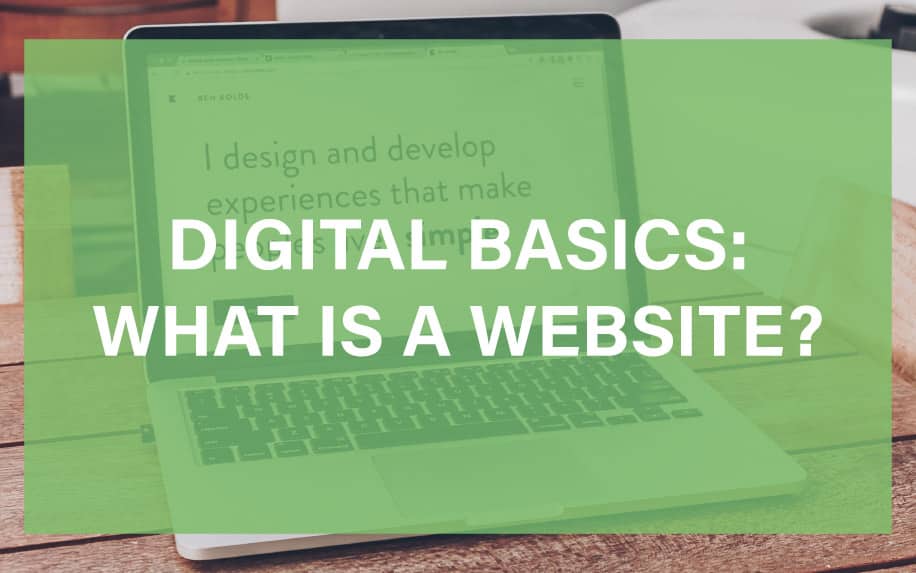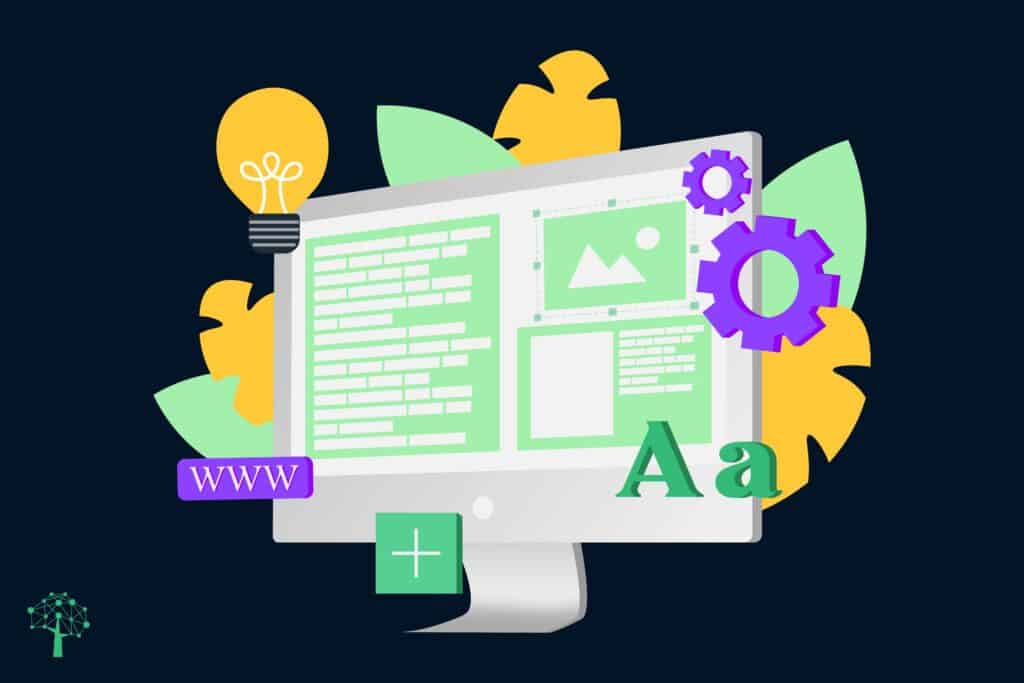Today, it’s more important than ever for small businesses to get online. However, many business owners aren’t tech whizzes. To help, we like to strip things back to the absolute basics. So what is a website?
Websites are an essential tool for reaching new customers and maintaining competitiveness. Since websites have become essential for modern business, let’s look at these vital building blocks of the online world.
The Birth of the World Wide Web:
The story of websites began in the 1960s with the advent of packet-switching technology, which enabled the transmission of data packets over a network of interconnected computers. This laid the foundation for the creation of ARPANET, the precursor to the internet, in 1969.
In the 1980s, a young physicist at CERN, Tim Berners-Lee, envisioned a system for sharing information across the network in a more user-friendly manner. He proposed a system called the World Wide Web (WWW) based on hypertext, a concept that allowed users to link documents and navigate through them seamlessly.

In 1991, Berners-Lee developed the Hypertext Markup Language (HTML), the foundation of web page creation, and the Hypertext Transfer Protocol (HTTP), the protocol that governs communication between web servers and browsers. He also created the first web browser, WorldWideWeb, and the first web server on the NeXT computer.
Let’s take a closer look at the essentials…

Table of Contents
What is a Website?
Technically, a website is nothing more than a collection of text files hosted on a server somewhere. However, for business owners, it’s more helpful to think of your website as an online platform for your customers to interact with you.
To define a website it’s helpful to consider what types of people would have a website.
Anyone and everyone can have a website, including businesses of all sizes and types, non-profit organisations, charities, governments, religious organizations, individual people, celebrities, musicians, entertainers, entertainment venues and more.
How many web pages a website includes varies based on many factors, such as the topic of the website and how much content it covers.
Business websites also generally have additional features beyond just information. This can include a system for users to make a purchase or book a service, as well as interfaces for them to sign up to your email list.
However, business owners don’t generally need to get bogged down in how their website works. Rather, it’s important to have enough of a basic understanding to make informed decisions about the web development process.
Creating a website can be a fraught process, especially if you don’t have a great knowledge of the technical side of things. With that in mind, let’s take a quick detour.
Quick Fix Websites – A Warning!
In the early days of the internet and web, creating a website was complicated and expensive. Essentially, you had to know how to build it yourself using computer code, and then upload it to your hosting server.
Now it is much simpler and more user-friendly for even nontechnical people to create a website. However, businesses should beware ‘quick fix’ websites as these can be badly set up for user-experience and search engine optimisation.
This might prevent you from reaching your goals. You’ll then have to engage an agency to create a proper website for you. In the long run this is a waste of time, and potentially even money.
As such, it’s crucial to do your research and invest in the right website from the outset.
Additionally, while it’s possible to create a site which looks great using a website builder, there are many functional elements which you may have insufficient knowledge of. For example, it will take you a long time to get your head around metadata and internal linking.
Some links lead the reader of a website to another website.
There are tools now available that make it quick and easy to get a website set up and running, but it remains an important consideration to choose the right one, or decide if you’d be better off with a professionally developed website.
Types of Information on Websites
A website contains a variety of types of material. Often, this takes the form of written content. Some websites include a feature that translates the content into another language or multiple languages.
A website can also contain graphics such as artwork and photographs, as well as audio, video, animation, and more.
Business websites also contain essential information about the business itself, like it’s location, services and history. They also contain information for job seekers, such as career information, job listings and a digital job application form.
Purpose of Websites
Websites serve many purposes, such as:
- Entertain users,
- Persuade website visitors to buy a product,
- Convince visitors to agree with certain ideas and causes,
- Encourage visitors to contribute to a charitable endeavour or project,
- Market or sell a product or service,
- Inform website visitors about a cause or particular issue.
The purpose of some websites is primarily to sell products or services. So much shopping takes place through websites. Shoppers can easily move, or navigate, through online stores and make purchases.
They pay for those purchases with various forms of payment, such as credit or debit cards. Websites have built-in security features that make shopping on the internet secure.
Promotional Websites
Some websites are somewhat similar in content and purpose to paper brochures, as they contain some informational and promotional content..
However, a website is much more than that, and one of the beauties of a website is that it can be updated much more readily than any paper document can be. You might even update your site on a regular basis.
Many websites feature blogs, which include articles like a magazine. Blog posts can be varying lengths and can be posted to a website as often as desired.
Those are just some of the possible purposes of a website. A website can serve any purpose that the creator of that website has in mind. These days, most websites have a combination of all of these features.
How People Can View and Access Websites
A person first needs access to the internet, to be able to get to websites. They also need to type in a particular website’s address, also called a URL, into the address bar in an internet browser.
Alternatively, users can find your site through search engines or links from other sites.
People use a variety of electronic devices to view websites. These include:
- Desktop computers,
- Laptop computers,
- Tablets,
- Mobile phones.
The experience a person has in viewing websites varies based on what device they are using. A desktop computer with a large monitor allows the website visitor to see much more content at one time than a visitor using a mobile phone with a tiny screen.

Most websites today respond to the size of the user’s screen. This allows them to get the best possible experience.
What are Website Cookies?

A cookie is a piece of information that your computer or other electronic device receives from a website you visit. Your computer stores that information. Then your computer sends that same information back to the website you visited.
Cookies can be both a blessing and a problem, depending on what they are doing at any given time. They both make it more straightforward for a computer to access websites and can be a challenge if a computer user does not properly deal with them.
Why does all of this happen?
The website you visit uses cookies to monitor your activity in browsing that website. Cookies can come in handy for many purposes online. For example, if you’ve ever shopped for anything online, cookies make your shopping experience more enjoyable, easy and efficient.
Cookies for Logins
Another helpful task that cookies perform is keeping track of a user’s visits to the website where a person would log in, thus making their logins more seamless and quick.
There are various kinds of cookies that serve different purposes online, but those purposes can provide for better and more efficient browsing on websites on the internet.
Different computers are different from each other, but there are ways to go into a computer’s setting within an internet browser and view the settings for cookies. From there, it is possible to modify those settings based on your preferences.
Although some cookies can be harmful, many are helpful. The latter make the browsing experience better, so it is a wise idea to enable certain cookies. It is possible to delete cookies later if needed and desired.
The Metamorphosis of Websites: From Static Brochures to Dynamic Digital Hubs
In the early days of the internet, websites were predominantly static online brochures, serving as digital storefronts for businesses to showcase their products and services. These early websites were primarily informational, providing basic company details, contact information, and product descriptions. However, the rapid advancements in technology, coupled with the ever-increasing demands of users, have propelled websites into sophisticated digital ecosystems that play a pivotal role in modern business operations.
The Rise of Interactive Experiences:
The evolution of website functionality is marked by a transition from passive information delivery to interactive user experiences. Websites now incorporate a range of dynamic features that engage users, enhance their browsing experience, and facilitate seamless interactions with businesses. These interactive elements include:
- User-friendly navigation: Websites now employ intuitive navigation menus, search functions, and breadcrumb trails to help users easily find the information they need.
- Rich media content: Videos, images, and interactive graphics have become integral components of websites, captivating users’ attention and conveying information in a more engaging manner.
- Real-time data integration: Websites are increasingly integrated with real-time data streams, such as live chat features, social media feeds, and dynamic product updates, providing a more personalized and responsive user experience.
The Integration with Sales and Service:
Websites have transcended their initial role as mere online brochures and have become integral components of sales and service strategies. Websites now seamlessly integrate with customer relationship management (CRM) systems, enabling businesses to:
- Capture and manage customer data: Websites collect user information through forms, subscriptions, and purchase transactions, allowing businesses to build detailed customer profiles.
- Nurture leads and drive conversions: Websites incorporate lead capture mechanisms, email marketing automation, and personalized content recommendations to guide users through the sales funnel.
- Provide self-service support: Websites offer knowledge bases, FAQs, chatbots, and interactive troubleshooting tools, empowering customers to find solutions independently.
Emerging Trends and Future Directions:
The evolution of website functionality is far from over. As technology continues to evolve and user expectations rise, websites are poised to become even more sophisticated and integrated into the fabric of business operations. Emerging trends include:
- Voice search and conversational interfaces: Websites are adapting to voice search, enabling users to interact with websites through natural language commands.
- Artificial intelligence (AI) and machine learning (ML) integration: AI and ML are being used to personalize user experiences, provide predictive recommendations, and automate customer service interactions.
- Augmented reality (AR) and virtual reality (VR) integration: AR and VR technologies are being explored to create immersive experiences that allow users to virtually interact with products and services.
Latest website adoption metrics, including global totals, growth trends, and insights into the sophistication of websites used by leading businesses:
Global Website Adoption:
- Number of Websites: According to Internet Live Stats, there are currently over 1.9 billion websites worldwide. This represents a staggering growth of over 1,000% since the first website was created in 1991.
- Website Growth Rate: The number of websites is growing at a rapid pace, with an estimated increase of over 12% in 2022 alone. This growth is being driven by factors such as the increasing affordability of web hosting and domain names, the proliferation of mobile devices, and the growing popularity of e-commerce.
- Website Usage: The average internet user spends over 2 hours per day browsing websites. This makes websites one of the most popular forms of media consumption in the world.
Website Sophistication among Leading Businesses:
- Mobile-First Approach: Leading businesses are increasingly adopting a mobile-first approach to website design, ensuring that their websites provide an optimal user experience across all devices.
- Data-Driven Decision Making: Websites are becoming increasingly data-driven, with businesses using analytics tools to track user behavior, measure website performance, and inform their design and marketing decisions.
- Personalization and Customer Experience: Leading businesses are leveraging personalization techniques to provide users with tailored content, recommendations, and experiences, enhancing customer engagement and satisfaction.
- Integration with Sales and Marketing Automation: Websites are being integrated with sales and marketing automation tools, allowing businesses to streamline lead generation, nurture customer relationships, and drive conversions.
- Emerging Technologies: Leading businesses are exploring and adopting emerging technologies such as artificial intelligence, augmented reality, and virtual reality to create immersive and interactive website experiences.
These metrics and insights demonstrate websites’ immense scale and rising sophistication in today’s digital landscape. Websites have evolved from static online brochures to dynamic digital ecosystems that play a crucial role in business operations, customer engagement, and overall success.
Understanding Websites for Business Owners
These days, pretty much every business needs a website. In the digital era, this is simply the most effective way to reach your customers. However, the majority of business owners are not computer geeks.
Understanding the digital world means understanding websites. Before thinking about building the presence of your business online, taking these few minutes to go ‘back to basics’ can make for a great starting point.
Having a basic understanding of what websites are and how they work is also vital for making an informed decision about investing in a site which will help you reach your business goals.
Website Development and Maintenance Retainer Models
Website development and maintenance retainer models are agreements between businesses and web design firms that provide ongoing website support and enhancement services for a fixed monthly fee. These retainer models offer several benefits for both parties:
Benefits for Businesses:
- Predictable Costs: Businesses can budget for ongoing website support and enhancements without the uncertainty of hourly or project-based pricing.
- Proactive Maintenance: Retainer models ensure that websites are regularly updated, maintained, and optimized, minimizing downtime and security risks.
- Priority Support: Businesses receive priority access to support for technical issues, bug fixes, and updates.
- Enhanced Engagement: Ongoing website enhancements help businesses keep their websites fresh, engaging, and aligned with their evolving marketing goals.
Benefits for Web Design Firms:
- Recurring Revenue: Retainer models provide a steady stream of income, enabling web design firms to plan their resources effectively.
- Long-Term Client Relationships: Retainer models foster strong client relationships and encourage repeat business.
- Reduced Client Churn: The predictability and value of retainer models help reduce client churn and increase customer retention.
Common Retainer Models:
- Basic Maintenance Retainer: This model covers routine website maintenance tasks such as software updates, plugin updates, security patches, and basic troubleshooting.
- Enhanced Maintenance Retainer: This model includes the services of the basic retainer plus additional features such as performance optimization, content updates, and minor design tweaks.
- Full-Service Retainer: This model provides comprehensive website support, including ongoing development, content creation, marketing optimization, and advanced technical support.
- Custom Retainer: This model allows businesses to tailor a retainer package to their specific needs and budget, combining elements from the different retainer models.
Choosing the Right Retainer Model:
The choice of retainer model depends on the size, complexity, and ongoing needs of the website. Businesses should consider their website’s traffic, frequency of updates, and desired level of support when selecting a retainer package.
What is a Website? FAQ
Q: What is the typical duration of a website development and maintenance retainer agreement?
A: The duration of a retainer agreement can vary depending on the specific needs and preferences of the business and the web design firm. However, retainer agreements typically range from 6 months to 2 years.
Q: What happens if I need additional services outside of the scope of my retainer agreement?
A: If you require additional services beyond what is included in your retainer package, you may be charged an hourly rate or a project-based fee. It is important to discuss this with your web design firm upfront to ensure there are no surprises.
Q: How can I track the progress of my website maintenance and enhancements?
A: Web design firms typically provide regular reports to clients outlining the work completed, any issues identified, and upcoming tasks. Additionally, you can request access to a project management tool to track progress and communicate with your web design team.
Q: What are the key considerations when selecting a web design firm for a retainer agreement?
A: When choosing a web design firm for a retainer agreement, consider their experience, expertise, communication style, and ability to understand your specific needs. It’s also important to review their portfolio and client testimonials to assess their quality of work and customer satisfaction.
What is a Website? Conclusion
Website development and maintenance retainer models offer a valuable solution for businesses seeking ongoing website support and enhancements. These agreements provide predictable costs, proactive maintenance, priority support, and continuous improvement, ensuring that websites remain up-to-date, secure, and aligned with evolving business goals. By carefully evaluating their website’s needs and selecting a reputable web design firm, businesses can leverage retainer models to maximize the value and longevity of their online presence.


